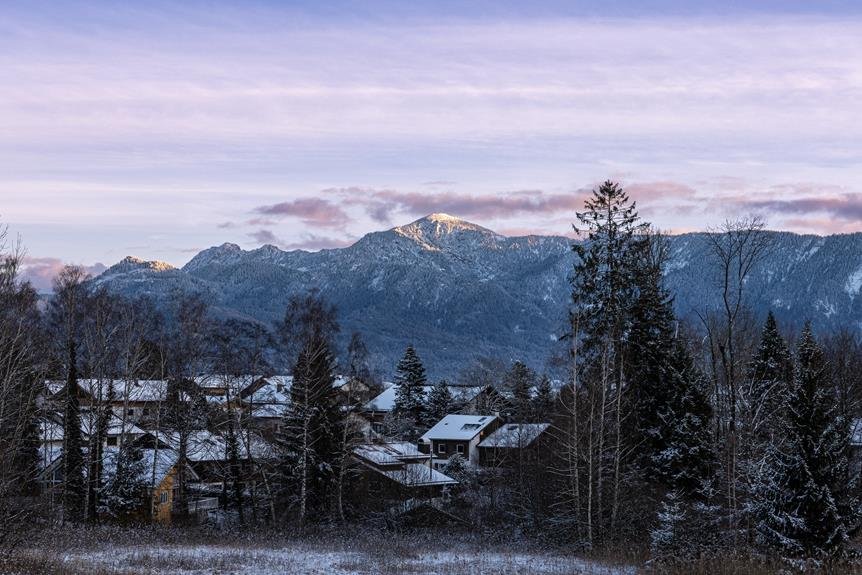Do you ever wonder if mold dies during the winter? Well, the answer might surprise you. In this article, we will explore the fascinating world of mold dormancy in the colder months.
Discover the factors that affect mold survival, the common areas where mold tends to grow in winter, and most importantly, how to prevent it from taking hold in your home.
Get ready to arm yourself with valuable mold control tips for the winter season.
Key Takeaways
- Mold goes into dormancy during winter, reducing metabolic activities.
- Lack of favorable conditions for growth in winter leads to mold dormancy.
- Lower temperatures inhibit mold growth, but some molds can still survive in colder temperatures.
- Mold requires moisture for growth, so water availability plays a crucial role in its survival.
Mold Dormancy in Winter
When winter arrives, mold goes into dormancy as it waits for warmer temperatures to thrive again. During this period, mold remains inactive, reducing its metabolic activities to a minimum. Mold spores are resilient and can withstand harsh conditions, including freezing temperatures. However, they enter a state of suspended animation, where growth and reproduction cease temporarily. This dormancy is crucial for mold survival in cold climates.
The primary reason for mold dormancy in winter is the lack of favorable conditions for growth. Mold requires moisture, warmth, and a food source to thrive. In colder temperatures, moisture levels decrease, and the air becomes drier, making it difficult for mold to find the necessary moisture to grow. Additionally, the colder temperatures slow down the chemical reactions within mold cells, hampering its ability to metabolize and reproduce.
While mold remains dormant during the winter, it's important to note that it doesn't die. As soon as the temperatures rise and favorable conditions return, mold will resume its activities and start growing again. This is why it's crucial to address any moisture issues in your home during the winter months, as dormant mold can quickly become active again when conditions improve.
Factors Affecting Mold Survival
To ensure mold survival during the winter, it's important for you to understand the factors that affect its ability to thrive. Mold is a resilient organism that can adapt to various conditions, but there are certain factors that can either promote or hinder its survival during the colder months.
Here are four key factors that influence mold's ability to survive in winter:
- Temperature: Mold thrives in warm and humid environments, so the lower temperatures of winter can inhibit its growth. However, some molds can still survive and remain dormant in colder temperatures, especially if the conditions aren't extreme.
- Moisture: Moisture is essential for mold growth, so the availability of water plays a crucial role in its survival during winter. Indoor humidity levels and water leaks can create an environment conducive to mold growth, even in colder temperatures.
- Food Source: Mold requires organic materials to feed on, such as wood, paper, or fabrics. If these materials are present and provide sustenance, mold can still survive and grow during winter.
- Indoor Conditions: The conditions inside buildings can significantly impact mold survival. Proper insulation, ventilation, and humidity control can help prevent mold growth and promote a healthier indoor environment during winter.
Common Winter Mold Growth Areas
During winter, it's important for you to be aware of the common areas where mold tends to grow.
Mold requires moisture and organic matter to thrive, and certain areas in your home provide these ideal conditions even during the colder months.
One common area for mold growth in winter is the bathroom. The combination of moisture from showering and insufficient ventilation creates a perfect environment for mold to flourish on surfaces like tiles, grout, and shower curtains.
Another common area is the kitchen. Cooking activities, such as boiling water and using the dishwasher, can generate moisture that promotes mold growth on countertops, sinks, and even inside cabinets.
Additionally, basements and crawl spaces are notorious for mold growth during winter. These areas tend to have higher humidity levels, and if there are any leaks or water infiltration, it can create a damp environment that encourages mold to grow on walls, floors, and stored items.
Lastly, pay attention to areas near windows and doors. Poor insulation and condensation can lead to moisture buildup, making these areas susceptible to mold growth.
Preventing Mold in Cold Weather
To prevent mold in cold weather, it's important for you to be proactive in controlling moisture levels in your home. Mold thrives in damp environments, and even in the winter, when the air is generally drier, it can still grow in areas with high humidity or moisture. Here are four steps you can take to prevent mold in cold weather:
- Maintain proper ventilation: Ensure that your home has adequate ventilation, especially in areas prone to moisture buildup, such as the bathroom and kitchen. Use exhaust fans or open windows to improve airflow and reduce humidity levels.
- Monitor indoor humidity: Invest in a hygrometer to measure the humidity levels in your home. Ideally, indoor humidity should be kept below 50%. If it exceeds this level, consider using a dehumidifier to remove excess moisture from the air.
- Fix leaks promptly: Inspect your home regularly for any leaks or water damage. Address any issues immediately to prevent the growth of mold. Repair leaky pipes, fix roof leaks, and seal any cracks or gaps in windows and doors.
- Control condensation: Condensation can occur on windows, walls, and other surfaces in cold weather. Wipe down any condensation that forms and use insulation or weatherstripping to prevent warm air from escaping and condensing on cold surfaces.
Mold Control Tips for the Winter Season
To effectively control mold growth during the winter season, you should implement specific strategies to minimize moisture and maintain a dry environment in your home. Mold can still thrive in cold temperatures as long as there's moisture present, so it's crucial to take preventive measures. Here are some mold control tips for the winter season.
Firstly, ensure proper ventilation in your home. Proper air circulation helps to reduce moisture levels and prevent condensation, which can contribute to mold growth. Open windows for a short period each day to allow fresh air to enter your living spaces.
Secondly, monitor indoor humidity levels. Aim to keep the humidity below 50% to inhibit mold growth. You can use a hygrometer to measure the humidity in different areas of your home. If the humidity is too high, consider using a dehumidifier to remove excess moisture from the air.
Next, regularly check for and repair any leaks or water damage in your home. Inspect your roof, windows, and pipes for any signs of leakage. Fixing these issues promptly can prevent moisture buildup and subsequent mold growth.
Additionally, ensure proper insulation in your home. Insulating your walls, attic, and windows can help prevent cold spots where condensation can occur. Proper insulation also helps to maintain a consistent indoor temperature, reducing the chances of moisture buildup.
Lastly, make sure to clean and dry any wet or damp areas in your home immediately. This includes areas prone to moisture, such as bathrooms, kitchens, and basements. Use a fan or dehumidifier to speed up the drying process.
Conclusion
In conclusion, mold doesn't die in the winter but instead goes into a dormant state. Factors such as temperature, moisture, and available nutrients play a role in its survival during this season.
Common areas where mold can grow during winter include basements, attics, and bathrooms.
To prevent mold growth in cold weather, it's important to maintain proper ventilation, control humidity levels, and promptly address any water leaks or moisture issues.
Following these mold control tips can help ensure a mold-free winter season.






0 Comments